NIKKO 10x50 5°
| Das hier gezeigte 10x50 Monokular war Teil eines militärischen Theodoliten, wie er auch von Toko gebaut wurde. Das 10x50 hat zwei Zapfen am Tubus für eine Gabelhalterung zur Aufnahme auf einem Richtkries. Es ist aus Messing mit iener grünlich-braunen Lackierung. Als Grobvisier gibt es eine Kimme-und-Korn-Einrichtung, dessen Korn sich runterklappen lässt. Eine Sonnenblende lässt sich um 45mm ausziehen. Am Okular ist ein Strichplatte mit Beleuchtungseinheit eingebaut. Die Strichplatte hat ein horizontale Skalenlinie von Null bis 4 von der Mitte aus zu beiden Seiten. Links auf der "1" startet eine vertikale Skala bis 4. Mittels eine Stellrads rechts am Okular mit einer 100er-Skaleneinteilung kann eine weitere Strichplatte mit horizontalen Parlllellinien durchgehend gedreht werden. Das Okular hat eine Dioptrieneisntellung von +2 und -3. Die Augenmuschel war aus Bakelit. Zur Justierung gibt es unten am Tubus eine Libellenwasserwaage, sowie auch am linken Trägerzapfen, der auch eine Deklinationsskala bewegt (s. Toko 10x50. Der Gehäusedeckel ist mit der Vergrößerung und dem Sehfeld (5°), dem Nikko Logo sowie Nr. 438 beschriftet; daneben befindet sich das japanische Schriftzeichen für die "Luftstreitkräfte", darunter "JES" für "Japanese Engineering Standard" und Schriftzeichen für die genutzten Schrauben bzw. Gewinde. |
The 10x50 monocular shown was part of a military theodolite like it was also made by Toko. The 10x50 has two trunnions for a fork mount to bea ttched to an aiming circle. It was made of brass with a greenish brown lacquering. It came with a notch and bead sight, of which the bead can be folded down. A sunshade can be extended by 45mm. The eyepieces has a reticle with an illumination unit. It has a horizontal scale ranging from zero to four starting in the centre to both sides. There is another scale 1-4 starting at the "1" on the left of the horizontal line. A wheel with a 100 division scale on the right can continously turn a further reticle with parallel lines. The eyepiece has a dioptre adjustment ranging from -3 to +2. The eyecup was made of Bakelite. For alignments, there is a level on the tube bottom and on the left trunnion - the latter also moves a declination scale (cf. Toko 10x50. The top cover plate is inscribed with the mangification and angle of view (5°), the Nikko logo and Nr. 438; next to this ia the Japanese script sign for the Air Forces; below it says "JES" standing for Japanese Engineering Standard", and there is a sign for the kind of screws or threads used. |
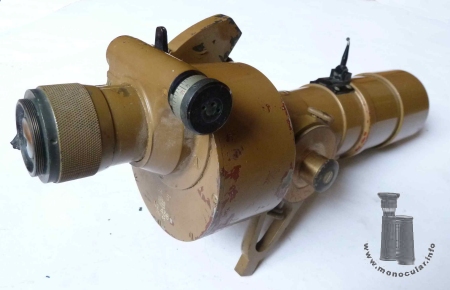
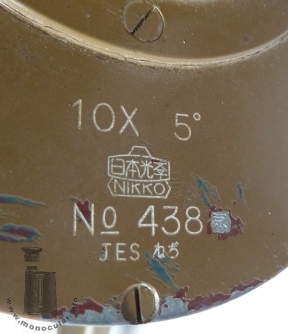
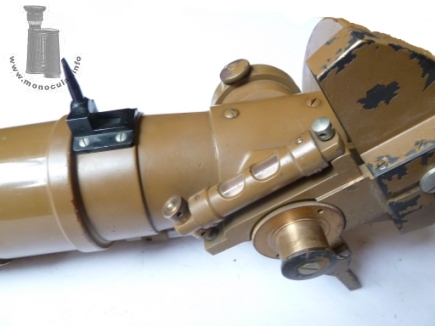
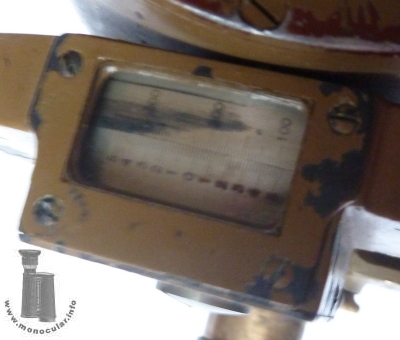
| Das Monokular im gezeigten Umfang wiegt 3685g. Es ist 30cm lang. Das Okularstück ist 37mm, der Fokussierungsteil 41mm im Durchmesser. Das 51mm lange Porro-2-Prismengehäuse ist 94mm, der Objektivtubus 51-64mm, die Objektivfassung 68mm und die Sonnenblende 73mm im Durchmesser. | The monocular as seen here weighs 3685g. It is 30cm long. The eyepiece is 37mm, the focusing part 41mm in diameter. The 51mm long porro 2 prism housing is 94mm, the objective tube 51-64mm, the objective frame 68mm, and the sunshade 73mm in diameter. |
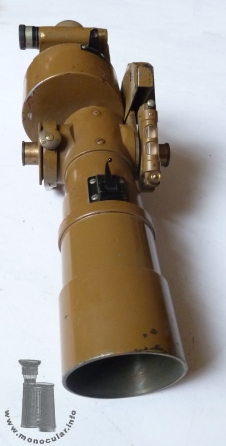
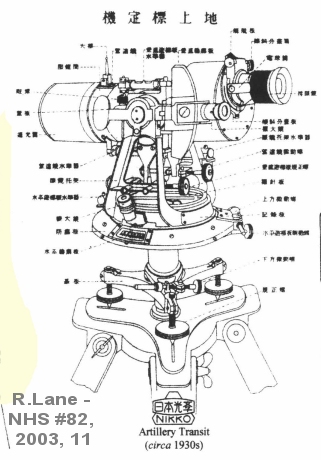

Fotos: Zeun; Skizze in R. Lane, 2003, S./p. 11

